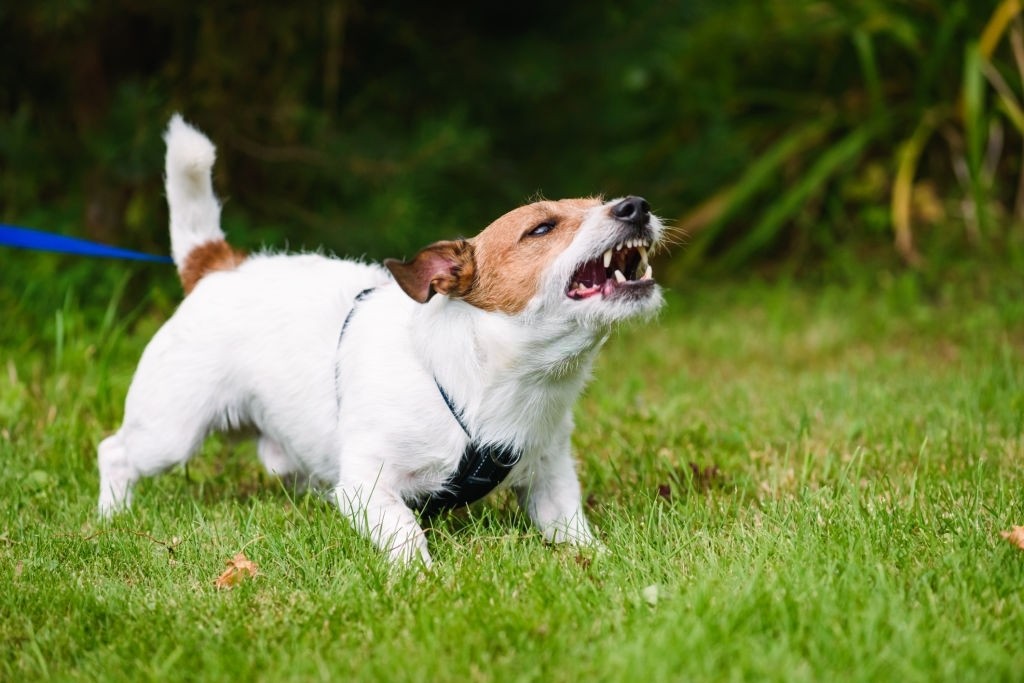Every dog owner wants their dogs to be cute and obedient. It’s ok if a dog seems mischievous and active. However, if your dog becomes aggressive towards humans or other animals, you should notice its signs and find a good way to get rid of aggression. How to correct aggressive dog behavior? Teach your pet friend a good manner and practice good habits.

What Is Aggression?
Aggression is a term referring to multiple behaviors that happen due to different reasons in different situations. Most wild animals are aggressive when they protect their territories, offspring, and save themselves. Species living in groups use aggression to keep peace and deal with relations. Dogs have aggression too.
When dog owners say that their dogs are aggressive, other people often think that the dogs easily get angry and bite; however, aggression expresses several meanings. Behaviors are different in dogs. Some only growl, while some bite other dogs or persons. Although aggression is one of the serious problems of your dog you have to solve, it’s possible to deal with behaviors and control them.
Although your dog shows signs of aggression, it’s important to understand and figure out the causes of its behaviors. There are many reasons for the aggression of a dog. Knowing basic reasons helps you to give it effective treatments as soon as possible.
Dogs can become aggressive when meeting strangers. Some even show aggression to family members. Dogs in the household or neighborhood are perhaps victims. Your dog can get angry with strange dogs. In some situations, dogs get aggressive towards guarding resources such as food, treats, or toys. Some dogs get aggressive towards other animals like birds or cats or certain objects.
Signs of Aggression
Any dog can express aggressive behaviors and the important thing is to notice signs of aggression. When it comes to a dog’s aggression, you need to observe many gestures and behaviors. Aggression consists of multiple behaviors starting with warnings and it can cause an attack as a climax. A dog that gets angry with humans often shows some continuous combative signs.
Which body language and signs do alert an attack? If you know the answer to this question, you can guess what the dog will do and prevent dangerous actions.
- Standing in a rigid still pose
- A threatening or guttural bark
- Moving forward or touching the person with no contact
- Bites of different intensity levels. Mouthing or light biting without applying pressure. Snapping or nipping at a person without leaving a mark. Biting that causes bruising or puncture wounds
- Punches the person with its nose
- Growling
- Showing teeth
- Snarling (growling while showing teeth)
Before a serious attack happens, there are always signs. You must focus on the unusual behaviors of the dog to solve the circumstance. You can see the popular signs mentioned above. Some dogs have a syndrome called Sudden Onset Aggression. Your dog will attack brutally all of a sudden without signs. However, most dogs show signs before becoming aggressive.
Causes of Aggression
It’s essential to figure out the reasons for aggressive behaviors. Knowing the cause helps you select the proper solution. Here are some common types of aggression of dogs. If you understand causes, it’s possible to find how to correct aggressive dog behavior.
- Territorial aggression: The dog protects its space or your house from animals that it considers as invaders.
- Protective aggression: A dog will defend members in its pack against another animal or person. A mom dog also protects puppies and easily becomes mad at anyone that accesses them.
- Possessive aggression: A dog protects foods, chews toys, bones or an object which is meaningful to the dog.
- Fear aggression: Your dog perhaps gets scared and tries to step back or run away in a dangerous circumstance. However, if it’s cornered or surrounded, it will attack.
- Defensive aggression: Like fear aggression, the dog attacks to protect something instead of running away. Dogs with defensive aggression often give a sign showing that they don’t want a fight before biting. For example, they can turn their head away.
- Social aggression: A dog possibly gets aggressive with other dogs in social situations. Dogs that don’t get on well with other ones and humans can express their aggression.
- Frustration-elicited aggression: A dog behaves aggressively when it is controlled by a leash or fences. In case the dog is interested in something, but it cannot do anything, it will become aggressive. Sometimes, the dog seems over-excited, for instance before a walk, it will nip its owner.
- Redirected aggression: This means your dog gets angry with another target. For example, it is about fighting with another dog, but you try to interfere with the attack. Your dog can attack you instead of that dog.
- Pain-induced aggression: The dog exhibits its aggression when it feels pain or gets injured.
- Sex-related aggression: Two male or female dogs show their aggression as they want to catch the attention of a mate.
- Predatory aggression: While chasing the quarry, the dog becomes aggressive without any signs. This instinct turns to a threat when a kid plays a chasing game with a dog. The dog is deep into the game and thinks of the kid as a prey. The child can be attacked and bitten.
- Genetic predisposition: Some dog breeds tend to get aggressive much more than other breeds.
Read more: How Do You Use A Clicker For Dog Training? Clicker Training
How To Correct Aggressive Dog Behavior?
Avoid threatening situations. It’s hard to keep an adolescent dog calm and make it play properly while it’s surrounded by young excited dogs. If your dog plays games violently, remove them. Choose quiet places to get less stressful. Go to a dog park when there aren’t many dogs there. Make sure that one of the dogs in the playground is an adult. Well-socialized adult dogs are good examples that teach young dogs good behaviors.
Build calm behavior. If your dog starts barking excitedly when it is near a dog park or a pack of dogs, you need to turn around and take it away from the dog park. Leave the playground or back to your car and wait until your dog calms down. If it doesn’t keep calm, take it home. Allowing your dog to repeat aggressive behaviors isn’t good for it.
Continue to introduce well-behaved adult dogs to your dog. Good adult dogs will interact kindly with your dog and interrupt aggressive behaviors. Adult dogs often communicate using eye contact at tall, still postures to prevent unwanted contact. Adult dogs interrupt by quick deep sound or snark, not a short fight.
Only allow your dog to repeat good behaviors. Remember that any behavior can become a habit if it happens many times. So, don’t let it cause bad behaviors again. Do dog park visits encourage your dog to chase and attack other dogs? Does your dog bark and bite other dogs or pass-by while you’re absent? Don’t be afraid of looking for new activities if current activities encourage inappropriate behaviors.
Teach your dog to calm down. Put it on a leash while you watch TV and ignore it. If the dog tries to sit in your lap, pull it away by the leash. If it barks, you need to ignore it. Wait until it sits quietly on the floor, then give it a compliment. If it jumps and makes noise, you have to ignore it again. This is called “settle” exercise. It helps your pet to figure out that keeping calm catches your attention.
Talk with a vet about the aggression of your dog, its signs. It’s necessary to talk with the vet about other syndromes. Hair loss or bodyweight gain along with aggression perhaps are signs of hypothyroidism. Aggression following convulsions or up-and-down mood can be caused by full or partial seizures. Damage to certain areas of the brain through diseases such as hydrocephalus, tumors, thyroid issues or trauma can also result in aggression problems.
Thyroid issues, serious wounds, or diseases like tumors and hydrocephalus will influence certain areas of the brain. This leads to the aggression of the dog. The vet has to diagnose your dog’s health to find the cause. If your pet is suffering a disease, prompt proper treatment is very important.
In case, the dog gets aggressive towards other animals. You should find the advice from an expert. Look for professional help. He can observe, evaluate its conditions and behaviors. Then, the expert comes up with a solution to control aggression and remove bad habits. Your dog cannot heal itself. Pieces of advice from a behavior expert are useful.
This video can help:
Conclusion
How to correct aggressive dog behavior? It’s not good if your dog shows aggression and attacks other dogs and persons. Don’t ignore signs of aggression. Especially, aggression following some syndromes warns health problems. You need to notice them and cure the dog promptly. To correct aggressive dog behaviors, you must make a detailed plan, avoid punishments, and be patient with your dog.
